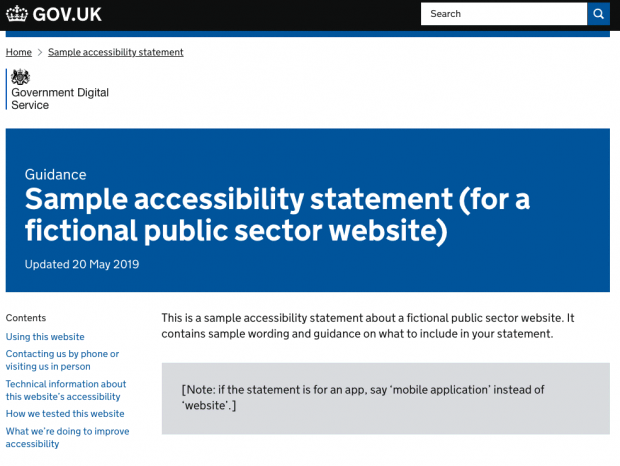Accessibility update: sample accessibility statement, monitoring and enforcement

Accessibility update: sample accessibility statement, monitoring and enforcement
Accessibility update: sample accessibility statement, monitoring and enforcement
Posted by: Anthony Ilona – Policy engagement manager, Posted on: – Categories: Accessibility
New regulations mean that public sector websites and mobile apps will soon have a legal duty to meet accessibility requirements. You’ll need to:
- carry out an evaluation of how accessible your websites and mobile apps are
- fix accessibility problems (when you’re required to do so)
- publish a statement saying what’s accessible, what’s not – and why
You’ll need to do this by 23 September 2019 for newer websites (those published later than 22 September 2018). There are later deadlines for older websites and mobile apps.
We’ve blogged about this a few times over the past months; here’s the latest on what’s happening.
Updated guidance on meeting accessibility requirements
We’ve updated the guidance on making your public sector website or app accessible.
We have:
- split the information that was there into two guides – one that’s focused on understanding your obligations and one that’s focused on the practicalities of making a plan to identify and fix accessibility problems
- added more detail on evaluating your website or app so you can publish an accessibility statement saying how accessible it is
You will find a link to a sample accessibility statement you can use to help you write your own. Thanks to colleagues at AbilityNet, JISC, Kent County Council, Nomensa, the University of Kent and others for their help putting this together.

Monitoring and enforcement
We’ve had some questions about how compliance will be monitored and how the regulations will be enforced.
A central monitoring team at GDS will assess a sample of public sector websites and apps. The aim of monitoring is to help and encourage the public sector to make timely improvements to websites and apps – making them accessible to as many people as possible and avoiding the need for enforcement.
The sample will be chosen based on a number of factors, including:
- how many people risk being excluded
- where there are known or suspected problems (for example, because there have been complaints)
If the monitoring team discovers accessibility problems with a website or app in the sample, they will notify the website or app owner and signpost them to support to help resolve the problems.
The monitoring team will be overseen by the Cabinet Office and supported by an independent panel of stakeholders.
Assuring compliance with the regulations will, in part, fall within the existing enforcement powers of the Equality Advisory & Support Service, the Equality and Human Rights Commission and the Equality Commission for Northern Ireland.
GDS – acting on behalf of the Minister for the Cabinet Office – will assess whether accessibility statements meet legal requirements.
The Equality Advisory & Support Service provides individuals with information about discrimination and their rights as users of public services.
We’ll publish further information on monitoring and enforcement processes in the future.
What’s next
Most public sector organisations will want to consider getting help from an external accessibility expert to evaluate their websites and apps. But for organisations that genuinely can’t afford to do that, we’re working on a simple approach to self-evaluation. We will aim to publish this soon.
Share this page
15 comments
-
Comment byKaren Winterposted on
Please could you clarify if this includes Parish Council websites?
-
Comment byAnthony Ilona, GDSposted on
Hi Darren,
Regulation 4 (2)g makes specific reference to intranets and extranets.
-
Comment byTim White B&NESposted on
Hi
Does this extend to websites without a .gov.uk domain too? We operate a number of commercial sites with a .co.uk. Are they in scope for this too?- Replies to Tim White B&NES>
Comment byAnthony Ilona, GDSposted on
Hi Tim,
It’s more about ownership of the site and its content than the domain name when considering legal compliance. According to the regulations, if third party content is neither funded nor developed by the public sector body concerned nor under its control, it is exempt.
- Replies to Tim White B&NES>
-
Comment byStephen Burkeposted on
Hi
Can you clarify the guidance please.
If the website was built before 23/09/2018, does the accessibility statement still need to be added to the website before 23/09/2019? Or should we ensure it is added before 23/09/2020?So far we have been working on the proviso that the accessibility statement should be added to the website by 23/09/2019 but that the work to meet the standards should be complete by 23/09/2020.
- Replies to Stephen Burke>
Comment byTony Ilona, GDSposted on
Hi Stephen,
The regulations state that existing websites (those published before 23 September 2018) must meet the required accessibility standard AND display a compliant accessibility statement on and after 23 September 2020.
Newly published websites (those published on and after 23 September 2018) are required to meet the same terms by 22 September 2019.
- Replies to Stephen Burke>
-
Comment byCharlotteposted on
Does the EU directive cover Universities? A definitive answer from government would be AWESOME.
- Replies to Charlotte>
Comment byAnthony Ilona, GDSposted on
Hi Charlotte,
While Universities are generally considered to be in scope of the regulations, we recommend that you seek professional advice for a definitive answer.
- Replies to Anthony Ilona, GDS>
Comment byEmmaposted on
Your answer to this question has me confussed?
'While Universities are generally considered to be in scope of the regulations, we recommend that you seek professional advice for a definitive answer'
GDS have set these deadlines, how can there be any questions that you can't answer? Who are we supposed to ask for definitive answers if GDS themselves can't answer questions?
- Replies to Anthony Ilona, GDS>
- Replies to Charlotte>
-
Comment bychris_debianposted on
Is this just public facing, or internal government websites, such as intranets?
Thanks,
Chris
- Replies to chris_debian>
Comment byAnthony Ilona, GDSposted on
Hi Chris,
There are requirements in the regulations that apply to non public-facing websites such as intranets and extranets.
- Replies to Anthony Ilona, GDS>
Comment bychris_debianposted on
Many thanks for the clarification, Anthony.
Chris.
- Replies to Anthony Ilona, GDS>
Comment byDarrenposted on
Which requirements specifically apply to Intranets and Extranets?
- Replies to Anthony Ilona, GDS>
Comment byJasonposted on
Are you sure? Section 4 (2) (g) states "These Regulations do not apply to the following content of a website or mobile application
of a public sector body…content of extranets and intranets published before 23rd September 2019, until such websites undergo a substantial revision;It goes on to say;
(3) In this regulation—
(b) “extranets and intranets” means a website that is only available for a closed group of people and not to the general public;
- Replies to Anthony Ilona, GDS>
- Replies to chris_debian>
-
Comment byagtrierposted on
Good to see that GOV.UK is implementing the new EU accessibility directive. In fact, that's good news for everybody!











Responses